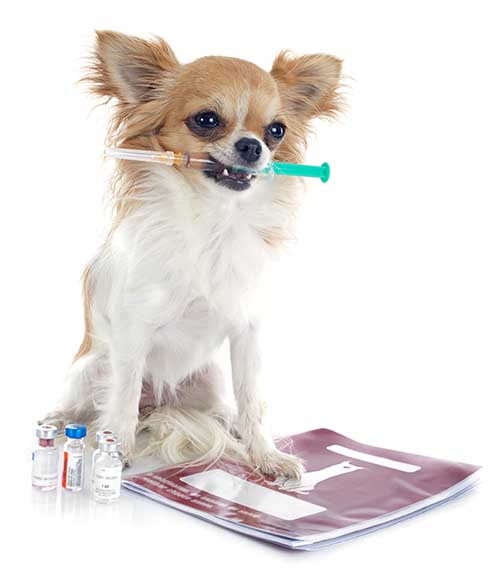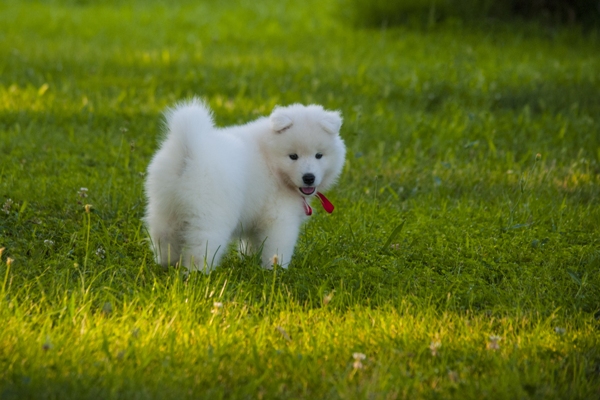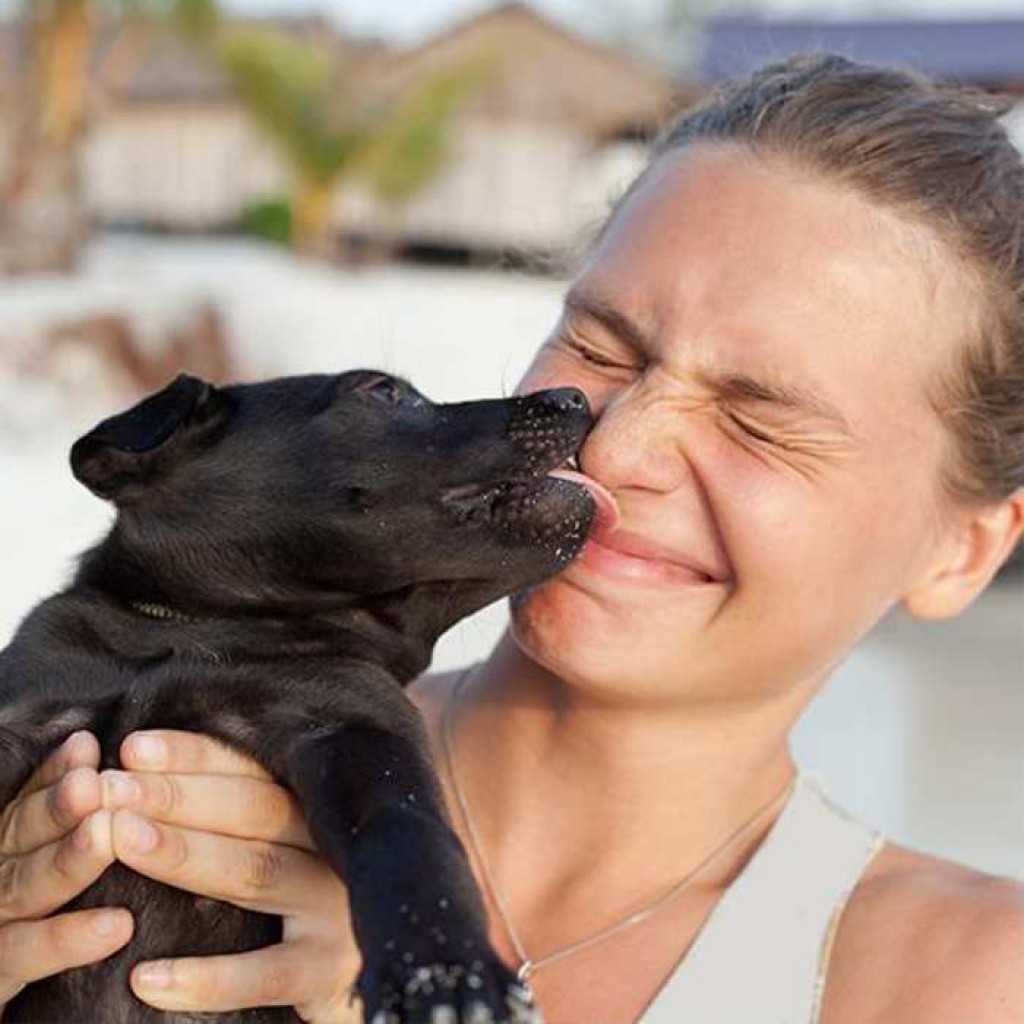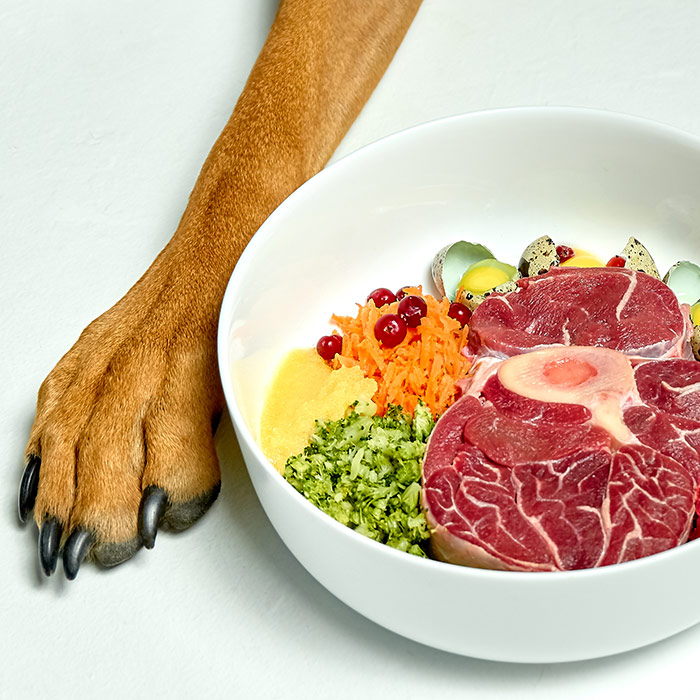Puppy feeding guide and schedule
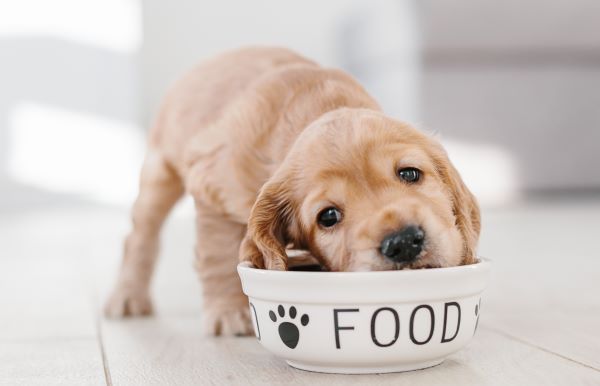
Along with a new puppy comes excitement, joy, fun and a myriad of questions. A lot of these revolve around puppy feeding and diet: How should I feed my puppy? What is the best puppy food? Is there a particular dog diet my puppy should follow?
 We know how confusing the world of pet food and puppy nutrition can be. From different brands of dry and wet foods, from grain-free to raw diets, and from subscription services to supermarket specials, there is a huge range of options to choose from.
We know how confusing the world of pet food and puppy nutrition can be. From different brands of dry and wet foods, from grain-free to raw diets, and from subscription services to supermarket specials, there is a huge range of options to choose from.
That’s why we’ve put together a puppy feeding guide to help you navigate this potential minefield and work out what the best option is for you and your puppy.
Understanding puppy nutrition
Proper nutrition is an extremely important component in maintaining the optimum level of health in your new puppy. Puppies grow very fast, particularly in the first five months, and they need to take in lots of calories and extra nutrients to fuel their rapid growth. Providing the proper nutrition is important for building strong bones and teeth, adding muscle, and supplying all the energy needed for play and learning.
Good puppy nutrition is about quality as well as quantity. Because puppies need so many nutrients to grow, it’s important to give them the very best puppy food that your budget allows, in order to provide complete and balanced nutrition.
Choosing the right puppy food
 To begin with, it is recommended to keep your puppy on the same puppy food that the breeder was providing. Once your puppy has settled in and you decide to switch to a different type of puppy food, or even a different brand of the same type, follow the guidelines below to slowly transition to the new food.
To begin with, it is recommended to keep your puppy on the same puppy food that the breeder was providing. Once your puppy has settled in and you decide to switch to a different type of puppy food, or even a different brand of the same type, follow the guidelines below to slowly transition to the new food.
If you are unsure what puppy food is best for your pup, you can start by asking your vet what puppy diet he or she recommends and why. Also ask about other options, for example homemade puppy food, wet dog food, raw food or alternative brands of dry dog food, and the pros and cons of each.
- See our article Different diets for dogs
Commercial puppy food options
There are so many different options of commercial puppy food available that making the right choice can seem overwhelming. Choose a premium brand that is free of preservatives and colourings. The first ingredient should be a meat, not a grain or a meat derivative. Premium pet food brands may be more expensive, but your pup will require a smaller portion in order to get all the necessary nutrients.
Make sure that you follow the feeding guidelines on the packaging to provide the right amount for your puppy’s age and weight. This may need to be adjusted weekly. It is also good to supplement your pet’s meals with fresh meats and some vegetables (ensure that you have removed bones from the meats and avoid foods that can impact negatively on their health).
PetfoodReviews is an independent review site that provides a detailed review of many common pet food brands available in Australia. See their page What’s the best puppy food? for guidance and factors to consider when selecting puppy food.
Homemade puppy food
If you choose to provide homemade dog food for your puppy, make sure you do so with guidance from your vet or an animal nutritionist so that you are providing all the necessary vitamins and minerals that young puppies require for optimal health.
Puppy feeding requirements and breed size
Breed size is an important factor to consider when choosing the right food for your puppy. Large breeds have different nutritional requirements from small breeds.
Feeding small breed puppies
Small breed dogs have higher energy levels than bigger dogs and tend to have faster rates of metabolism, so they require more energy from their food than large dogs do. Small breed puppy food needs to have a higher concentration of calories and quality nutrients, and should contain a good source of protein, healthy fats such as omega-3 and omega-6, and some grains. Food pieces should also be smaller and easier to chew than those for larger breeds.
Feeding large breed puppies
Large breed puppies grow at a much faster rate than small ones and come with a higher risk of overfeeding. According to several studies, if they are overfed, large breeds such as Great Danes, Labrador retrievers, and Doberman Pinschers are more likely to develop chronic skeletal and joint problems as they age. In one study that followed Labrador retrievers for 14 years, dogs fed a balanced diet with 25% less food than their littermates were less likely to develop hip joint arthritis. Dogs on the calorie-restricted diet also showed signs of arthritis at an average age of 12 years rather than six.
Large-breed puppy foods are designed for controlled growth and may be lower in calcium and phosphorus than other puppy foods (this is because excess levels of calcium and phosphorus can contribute to skeletal problems). Large-breed puppy food also may contain more fibre to add bulk to the diet without increasing the number of calories. Keeping your large-breed puppy at a body condition score of two out of five will help ward off the excess weight that can cause orthopaedic and other possible problems in later life.
Monitoring puppy’s health
A poor diet can have a direct impact on your pet’s skin and coat, weight, energy levels and gastrointestinal function. After 4 to 6 weeks on the puppy food, assess your puppy’s health as follows:
- Is your puppy playful and energetic?
- Is your puppy’s coat shiny and thick?
- Are your puppy’s faeces formed and brown?
If you answer yes to all of these, it is likely that your puppy is getting – and is digesting – enough nutrients from the food you are providing.
Monitoring puppy’s body condition

If you are unsure, you can evaluate your puppy using a “body conditioning score”. While very young puppies are expected to have some “puppy fat”, by 8 to 10 weeks puppies should be scoring a two out of five, which is relatively thin, with the tops of the back bones visible and no fat around the ribs. By five months, your puppy should be looking lean and have a waist and an abdominal tuck.
If you still have some concerns, we recommend you take your puppy to the vet for an evaluation. You may need to adjust feeding amounts or type of food, based on the vet’s evaluation of your puppy’s body condition.
Transitioning to a new type of puppy food
Dogs have a sensitive digestive system that is much more sensitive than ours. It is therefore recommended to transition your puppy to a new brand of puppy food over the course of 7 to 10 days so as to avoid runny stools and upset stomachs.
To transition to a new type of puppy food, a recommended approach is to use 80% old food on day one and 20% new food. The following day you will give your puppy 70% old food and 30% new food and so on, decreasing the old food and increasing the new food by 10% each day. Over the course of 7 to 10 days you will have transitioned your pup to the new puppy food and hopefully will have avoided loose stools and an upset tummy.
It is important to stick with one good puppy food. If you are feeding dry food (kibble), stay with one brand and do not mix as this could upset your pup’s digestive system.
Feeding chart for transitioning to a new type of puppy food
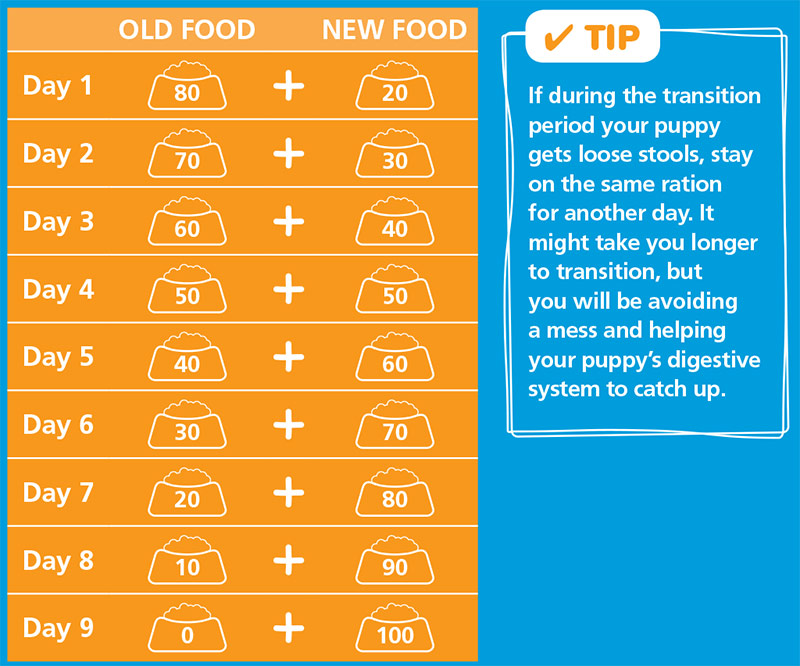
Common puppy feeding concerns
Overfeeding and obesity
Studies have shown that your dog will live a longer and healthier life if they maintain an optimal body weight, however, 40% to 70% of the pet population is considered obese.
Additional weight places excess strain on the musculoskeletal system, the heart, and the lungs. Excess weight can be shed fairly easily with proper diet and exercise.
Treats and snacks
Obesity in dogs is often linked to feeding table scraps. Avoid feeding your puppy table scraps, which teaches dogs to beg for food at the table and can cause digestive upset. Additionally, ‘human’ foods with a high fat content and can lead to a number of health related problems in dogs, such as inflammation of the pancreas, diabetes, diarrhea and vomiting.
Limit the number of treats you give your puppy and choose treats that are the right size for his breed. A small breed puppy doesn’t need an extra-large dog biscuit.
Transitioning to adult dog food
When puppies reach around 90% of their expected adult weight, their nutritional requirements change from a diet that promotes growth to a maintenance diet. For small breeds this may occur from age nine to 12 months; for large breeds, from 12 to 18 months.
- See our article Dietary requirements of adolescent dogs
Puppy feeding Q&A
New puppy owners tend to have lots of questions about the best dog diet, healthy puppy food and healthy puppy weight. While we cannot give specific food advice, we can provide some general feeding guidelines that will help you in raising a healthy puppy.
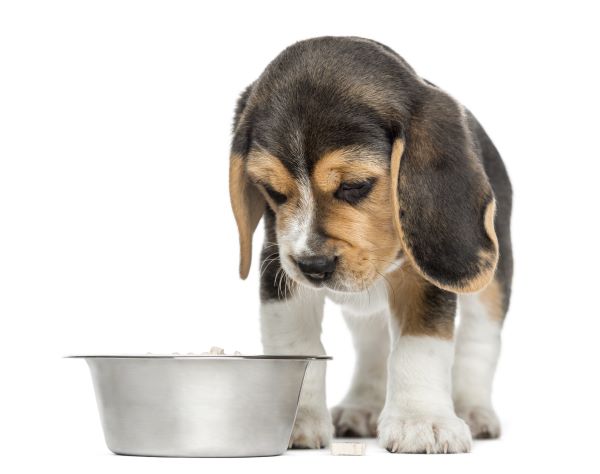
What should I feed my puppy?
Your puppy is growing and requires the best nutrients so look for a good quality food. Quality food is not only about the price tag, it is more about the ingredients. If a brand of pet food contains lots of preservatives, fillers, sugar and salt, then it is not a good quality food. Note that the best puppy food is sold predominantly in pet stores and by vets rather than in supermarkets.
Ingredients to avoid in puppy food
- Bone meal
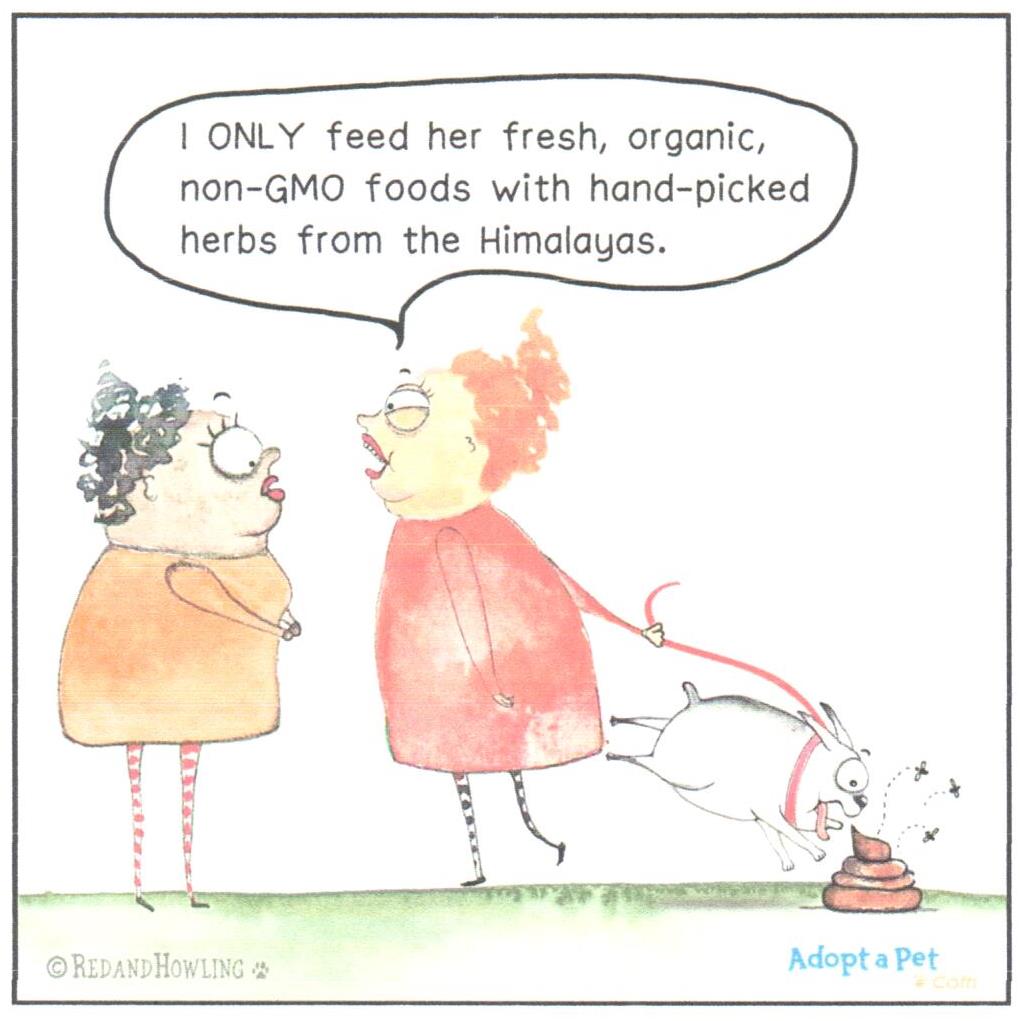
- Meat by-products
- Tallow
- Animal fat
- Corn
- Wheat flour
- Soy flour
- Brewer’s rice
- Cellulose
- Potato product
- Sugar
- Colouring
- BHA
- BHT
- Propyl gallate
- Ethoxyquin
- Hydrochloric acid
How much should I feed my puppy?
How much to feed depends on the brand of food you are feeding and your puppy’s weight. Always read and follow the instructions on the food packaging. You will need to adjust the quantity of food you are feeding over time as your puppy grows. It is therefore recommended that you weigh your puppy weekly and keep track of it on a puppy weight chart, to ensure your pup is putting on a healthy amount of weight.
How often should I feed my puppy?
Puppies under 6 months of age should be fed small quantities of good puppy food three times a day. After 6 months you can move to two feeds a day. If you work away from home, a puppy feeding schedule of three meals a day isn’t always feasible. Don’t stress if you can only feed your puppy two meals a day.
Is raw feeding a good dog diet?
Raw feeding can have a lot of benefits, including shinier coats, healthier skin, cleaner teeth, higher energy levels and smaller stools. More and more people are putting their dogs on raw food diets and raw feeding communities are popping up online.
Note that raw feeding involves much more than feeding your puppy just raw meats, which can lead to malnutrition. Finding the right balance of vitamins, minerals, proteins, meat, vegetables etc. is a science in itself and not for everyone. There are also serious hygiene concerns for owners from handling raw meat, particularly those with underlying health conditions.
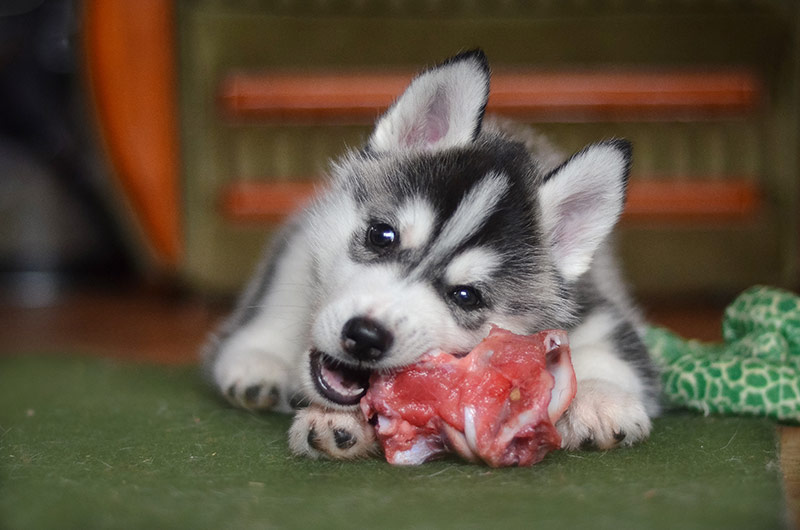
What is a healthy puppy weight?
An overweight puppy will be more likely to grow into an overweight adult dog. As your puppy is growing, carrying excess weight is not good for the joints. We recommend using a puppy weight chart to help you stay on top of your puppy’s weight gain and ensure that your puppy stays in the recommended weight range as he or she matures. Remember to always consult your vet if you have any concerns about your puppy’s weight gain.
Body condition score chart
It’s a great idea to use a body condition score chart to help you assess whether you puppy is at his ideal weight.
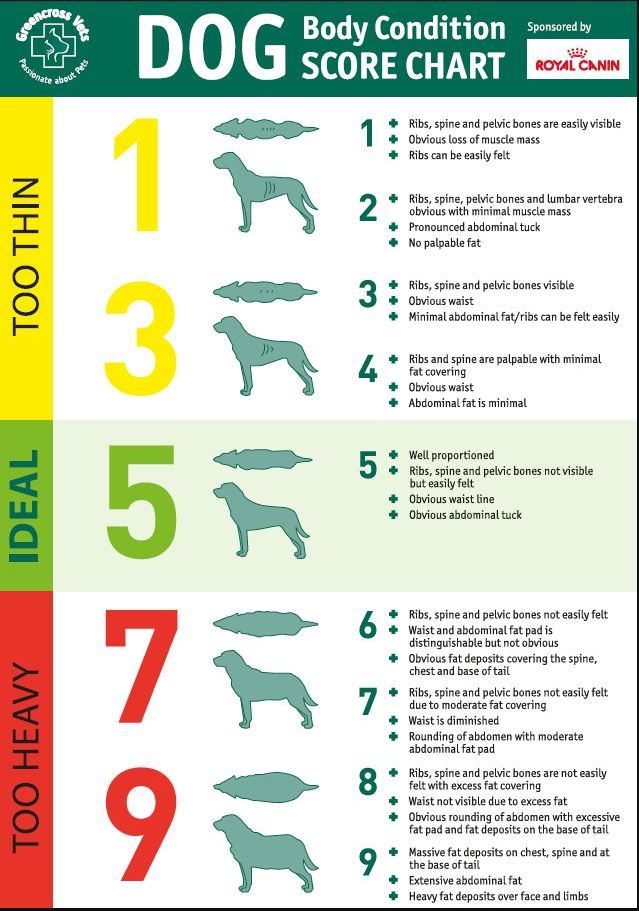
Read our Puppy Guide
Bringing home and looking after a new puppy can be a big challenge!
Our Puppy Guide is an easy to use comprehensive guide for new pet parents, jammed pack full of useful information, that has been developed by pet professionals and puppy trainers.
Get 2 months free pet insurance for your puppy!
Congrats on your new bundle of joy…
Bow Wow Meow Pet Insurance can help protect you and your puppy should an unexpected trip to the vet occur.
- Find out more about our dog insurance options






